 Today sees the beginning of Refugee Week here in the UK. More than ever we need to be nurturing compassion and empathy in our children so that they grow up able to recognise the toxicity of xenophobia and … Continue reading ...
Today sees the beginning of Refugee Week here in the UK. More than ever we need to be nurturing compassion and empathy in our children so that they grow up able to recognise the toxicity of xenophobia and … Continue reading ...
 Today sees the beginning of Refugee Week here in the UK. More than ever we need to be nurturing compassion and empathy in our children so that they grow up able to recognise the toxicity of xenophobia and … Continue reading ...
Today sees the beginning of Refugee Week here in the UK. More than ever we need to be nurturing compassion and empathy in our children so that they grow up able to recognise the toxicity of xenophobia and … Continue reading ...
On Friday I finally made it up to Newcastle to catch the National Centre for Children’s Books, Seven Stories’ exhibition Painting with Rainbows – A Michael Foreman Exhibition, which closes today (sorry!). The good news is that it will be heading out on tour: so far, it’s … Continue reading ...
Add a Comment
The UK’s 2016 Little Rebels Award shortlist has been announced – and once again it sets a challenge for the judges… It presents a good mix of books for all ages. There are some big names among the books’ creators – and notable is Gill Lewis’s Gorilla Dawn, … Continue reading ...
Add a Comment
Seven Stories is the UK’s “National Centre for Children’s Books” and has as its mission to save, share and celebrate Britain’s rich literary heritage for children.
It is part archive, part exhibition space, part playground, and it all adds up to something very special indeed.

Today it is celebrating its 10th birthday, and last weekend I was lucky enough to spend two days there revelling in its delights. I cannot recommend it highly enough; from its engaging exhibitions (fascinating for all; the littlest of children to the greyest haired grown-ups), to its opportunities to play and be inspired by the best of children’s books and book illustration (whether through art and craft activities, role play or dressing up), via its tremendous bookshop and lovely location, Seven Stories is the ultimate destination for anyone in the UK if you want to feed your imagination with the very best of words and pictures.
Located just outside the centre of Newcastle Upon Tyne, Seven Stories is housed in a former grain and flour warehouse (yes, with seven storeys) with a tremendous riverside setting.

Seven Stories is the building in the centre of this picture, with the boat moored outside the largest windows.

The 19th century industrial buildings in the neighbourhood make the setting very atmospheric.

The riverside setting for Seven Stories makes for a great area to explore.

The front entrance to Seven Stories.
Seven Stories has three main exhibition spaces and the first one we headed off to explore was Painting with Rainbows, packed with original illustrations and opportunities to explore the stories by Michael Foreman.

Foreman’s artwork when seen in real life simply sings off the page. Even though I know his work well, I was still taken aback by the vibrancy of his colours. It was such a treat to see some of my favourite illustrations of his up close and personal.

Lots of opportunity for play inspired by the illustrations on display are included throughout all the exhibitions, whether it’s playing at rock pooling alongside reading Foreman’s One World, or hiding under a replica Andersen shelter with a copy of War Boy.

Multiple copies of books and lots of seating space abound so there’s every opportunity for curling up with a good book either on your own or with a child or two in your lap!

Next up was Rhyme around the World, showcasing the artwork from the stunning poetry anthology Over the Hills and Far Away – A Treasury of Nursery Rhymes from Around the World alongside much of the original artwork from the classic poetry anthology Lavender’s Blue compiled by Kathleen Lines, illustrated by Harold Jones.

A third exhibition space explored the different illustrators who have worked on Paddington Bear over the more than 50 years that Michael Bond has been telling the marmalade loving bear’s stories, but it was the attic space which most excited my children.
Huge cut-out illustrations by Jim Kay of Diagon Alley lined one long wall in this brilliant performance space. The images are taken from the new fully illustrated, non-abridged version of Harry Potter and the Philosopher’s Stone which will be published in October.


There were also plenty of Hogwarts school uniforms to dress up in and this simplest of activities really captured my kids’ imagination.
The attic is used for live storytelling and theatre productions, all free as part of your entry ticket. The two shows we saw whilst there, including one inspired by Chris Haughton’s Shh! We Have a Plan were excellent. There’s also an ongoing programme of author and illustrator visits throughout the year – in the next few weeks Jonny Duddle, Derek Landy, Sarah Crossan and Patrick Ness are amongst those you can go and hear.
WHEN (not if, but when) you make your visit to Seven Stories pack your back (and wallet) in such a way that you can make the most of their fabulous bookshop, which is especially strong on picture books.


The bookshop has plenty of space for browsing and also contains a cafe. You can visit the cafe and the bookshop without having to visit the rest of Seven Stories.
There were many more lovely details that made Seven Stories special, from the design of the rubbish bins, to the mural on the cafe wall and more.


A small part of the mural on the cafe wall

Enjoying one of the areas dedicated to simply sitting down with a good book!
In a time when libraries are being closed and museum and arts funding is under constant threat it is a special joy to see Seven Stories full of life and energy. It’s a gem of a museum and family-friendly space, with imaginative curation and design, thoughtful and engaging staff eager to talk about stories and the sort of richness within its wall that will inspire long after you’ve left.
Here’s to you, Seven Stories! Wishing you a very happy 10th birthday, and looking forward to the next 10 years of exciting exhibitions and events!
 The power of ideas and the resilience which comes with imagination are key themes in Michael Foreman‘s fabulous celebration of stories, The Little Bookshop and the Origami Army, about a bookshop threatened with closure.
The power of ideas and the resilience which comes with imagination are key themes in Michael Foreman‘s fabulous celebration of stories, The Little Bookshop and the Origami Army, about a bookshop threatened with closure.
Developers want to replace the bookshop with a supermarket but hope arrives when an energetic and powerful superhero, Origami Girl, folds herself out of a newspaper delivery boy’s bag. She summons an army of friends out of the pages on the shelves of the bookshop and local library, and when builders and the local bigwig come face to face with characters they themselves loved in the books they read as children, do you think they can still continue with their plans to bulldoze the bookshop?
There’s so much to enjoy in this optimistic and not a-political picture book. From the very first illustration, which I’m sure is semi-autobiographical (Foreman himself was a newspaper delivery boy, and the blue and white scarf is perhaps a nod to his life-long support of Chelsea football club), to the final pages showing a completely different building project which really serves the local community, each spread from Foreman has something to make readers smile and feel empowered.
The story arc reminds me of Foreman’s piercing and brilliant War and Peas; Conflict and peaceful resolution are key themes throughout his oeuvre, perhaps unsurprisingly for one whose outlook on life has been so coloured by his experience of World War 2 and the Cold War (the former engagingly explored in War Boy).
Colour plays a powerful role in the illustrations in The Little Bookshop and the Origami Army. Yes, Foreman is known for his intense blue washes, and they are present here, but by counterpointing these with flashes time and again of rainbow hued details (the passing train, the children’s outfits, the railway bridge arches), the blue lifts and brightens, and the palette and composition of his spreads embody energy and hopefulness. For me, each rainbow splash is like a shaft of sunlight hitting the page.
Fictional characters coming to life have a long and wonderful history. Two of my favourite examples are to be found in Otto the Book Bear by Katie Cleminson and Eleanor’s Secret, a marvellous animated film which deserves to be much more widely known. Classics old and new are represented in Foreman’s visionary army, with McKee’s Elmer and Ross’ Little Princess marching alongside Alice, Puss in Boots, Toad of Toad Hall and many more, including some of Foreman’s favourites from earlier books of his. This playfulness seems to me a Foreman hallmark; when I interviewed him I was especially struck by the twinkle in his eye and joie de vivre. His sense of mischief shines through too: The spread showing politicians snoring in parliament is a hoot!
Unfortunately, the future for bookshops is not as bright and rainbow filled as Foreman’s rich book suggests. Just this week Saltaire Bookshop has announced that it may have to close in 6 months time, with takings currently averaging only £2 a day. The stats for the UK are bleak: Ten years ago there were 1,535 independent booksellers here, but by 2014 there were only 939. Interestingly, the situation in the US seems more hopeful: According to the American Booksellers Association, the number of independent bookshops (or should I say bookstores) in the U.S. has grown significantly in the last 5 years (figures differ, but if you’re interested, take a look here and here).
I can only encourage you to do your bit to ensure there continue to be local independent bookshops to feed our imaginations by getting your own copy of this loving ode to the impact books can have on us and the value of places which store stories for us all by seeking out your own copy of The Little Bookshop and the Origami Army. It will make your book-loving heart sing!
Inspired by Foreman’s fabulous book we wanted to create our own bookshop full of origami characters. First we had to fill our shop with books, and not just any old books, but edible ones. These were made with little chewy sweets (fruit salads), but you could use any small individually wrapped rectangular sweet.

We also included in our inventory these enticing books:

I hope the image below gives you a good enough idea of how to make these books yourself. If you do use fruit salads or blackjacks (in the UK) you can use my printout for the words on the pages by downloading from here. Each double page spread is a excerpt from a different Grimm’s fairy tale so you can include everything from Rapunzel to The 12 Dancing Princesses in your bookshop.

The fairytale texts were attached to the sweets and book covers (small slips of cardboard) using tiny glue dots.The second type of book was made out of fig rolls (fig newtons) and strips of dried fruit / fruit leather (we used these), with writing icing to decorate the covers.
Once our bookshop stock was ready we had to build some shelves and create some origami characters to hide in amongst the books:

We used Densho Origami: Traditional Japanese Figures for Everyone to learn how to make origami figures. It was ideal for my 10 year old who quickly graduated to the more complex projects, but J, at 7, also found the instructions for the simpler patterns easy to follow.

Finally our bookshop had a grand opening. You can imagine how many books got eaten in the celebration!

Whilst making our little bookshop full with origami friends we listened to:
We also tried learning The Origami Song…. it’s surprisingly addictive!
Other activities which would go well with reading The Little Bookshop and the Origami Army include:
Disclosure: I received a free review copy of this book from the publishers.
If you liked this post you might also enjoy these other posts of mine:

If you’d like to receive all my posts from this blog please sign up by inputting your email address in the box below:
Delivered by FeedBurner
 Michael Foreman is someone rather special.
Michael Foreman is someone rather special.
He’s often described as a “national institution”, with a 50 year back catalogue of tremendous books for children and young people. I, however, think this is perhaps a little too staid a description for someone who has such sparkle in his eyes and who gently radiates a real sense of joie de vivre, hopefulness, and energy when you hear him speak about his work. Foreman may have turned 77 earlier this year, but his illustration and storytelling continues to innovate and be full of forward looking optimism, alongside the beauty and wonder which was there from the beginning.
Twice a winner of the Kate Greenaway Medal, once in 1982 for the anthology “Long Neck and Thunder Foot -Sleeping Beauty and other favourite fairy tales” and then again in 1989 for War Boy: A Country Childhood, my own introduction to Foreman’s books as a child was through the eyes of a dinosaur and a panda: The copies from my 1970s childhood of Dinosaurs and all that Rubbish and “Panda’s Puzzle” are still much loved, not least by my own children.
I’m not a great one for the cult of celebrity, but I’m humbled and excited beyond measure to bring you today an interview with Michael Foreman, an author and illustrator whose stories have become embedded in my life, bringing it richness and – in both a literal and metaphorical sense – lasting colour.

Playing by the book: War Game, War Boy and After the War was Over are gifts to the interviewer. Your childhood home, life and extended family play an enormously important role in your work it seems to me. There’s a real grounding in a location and time that echoes through your work. And yet, alongside this inward reflection, there’s a big, wide-open view onto the wider world – a curiosity about our planet, a passion for travel, a keen interest in sharing this wider world with us your readers, a passion just as strong as for seasides, Suffolk and your family. How has this ability to look generously in both directions come about do you think? I’ve wondered if it has something to do with the way the world came to you during the war, with soldiers and POWs from all over passing through your home village.
Michael Foreman: Absolutely, yes. Family has been enormously important to me. The connections between generations – a sense of Time and Place. The questions my children have asked over the years – heightened now that we have new grandchildren – another rich source of stories.
Playing by the book: A wonderful animation was made of War Game and I understand there were plans for animated versions of War Boy and After the War too. What happened to these plans?
Michael Foreman: Nothing as yet, unfortunately. They are still awaiting funding.
Playing by the book: I do hope they get funded – I think they have such great potential. Having worked on animated films yourself in Denmark, what was the experience like for you to see one of your books re-imagined in another medium? (This stands for both War Game and The General, although I haven’t been able to track down a copy of the latter’s animation).
Michael Foreman: I was, of course, delighted that someone thought enough of the books to devote time and expertise to give my stories another life.
Playing by the book: These three books are all in one way or another about or inspired by your own family. Have you done any genealogical research further back in time, before your uncles’ generation?
Michael Foreman: One of my nephews has done quite a bit of research but it really just unearths earlier generations of fisher-folk.
Playing by the book: How would you feel if the makers of ‘Who do you think you are?’ approached you? Would you consider writing an up-to-date autobiography, including some of the more curious aspects of your career as a writer and illustrator? I’m sure there are some interesting stories to tell and scenes to paint from having worked at Playboy, with JG Ballard at Ambit magazine, for the police drawing female suspects when Identikit only catered for men and even working in the education/outreach department of Chelsea football club!
Michael Foreman: In October, Pavilion Books are publishing a retrospective view of many of the books I have done for them. War Boy, War Game, etc plus collaborations with Terry Jones and Michael Morpurgo, Edna O’Brien, Madhur Jaffrey, etc and classics like ‘Alice’s Adventures in Wonderland’ and ‘The Wind in the Willows,’ and two collections of Fairy Tales. The book, ‘A Life in Pictures’ also touches on some of my travels and working for magazines around the world.

Playing by the book: In the forthcoming exhibition at Seven Stories I understand there will be some sort of re-creation of your studio. Can you share a little bit about your favourite materials to work with – what sort of paper you like (what paper is good for different projects), what pencils and watercolours are your favourite for studio work, or for sketching on location? What is your top tip for anyone (but particularly children) who want to try out watercolour painting?
Michael Foreman: I am reluctant to give tips to anyone – I feel it is important to be able to draw well – but, I’m not sure it’s taught in Art Schools these days.

Liquorice Comforts – suck them and then use them as face paints! (It really works – I tried it out as research for this interview!)
Playing by the book: Over time it seems to me you’ve used some unusual art materials – here those liquorice comforts pop up again, and I’d be more than game for seeing if they still make great face paint, or can even be used on paper. Then there’s the biscuit tin paper linings you used as a child for drawing on, and I’ve also read you’ve used coffee grounds to create certain effects in your paintings. What other unusual art materials have you enjoyed / do you enjoy using?
Michael Foreman: I often use water colours because it allows the whiteness of the paper to shine through and illuminate the colours. Build up the colour from the back, layer upon layer. Sometimes the colours flow into one another, surprising you, sometimes disastrously, sometimes wonderfully. Go with the flow. You can always revert to a bit of acrylic to paint out mistakes which don’t work.

A spread from Michael Foreman’s Two Giants, published by Walker Books
In some of my early books, I used some collage – ‘The Two Giants’ and ‘War and Peas’ and, in ‘Mia’s Story’ I used scrap paper picked up from a rubbish dump in Santiago in Chile.

Two illustrations by Michael Foreman from Alan Garner’s The Stone Book
Alan Garner’s ‘Stone Book’ quartet, I illustrated with etchings.

An illustration for ‘The Day the Sun Hid’, in the anthology “Michael Foreman’s World of Fairy Tales”, published by Red Fox.
Playing by the book: Although blue is something of a signature colour for you, I think the choice of “Under the Rainbow” as a title for your new exhibition is wonderfully apt, for your use of the whole spectrum of colours is something very special (a personal favourite is the image from The Day the Sun Hid, where tremendous blues and greys are offset by rainbow coloured weaving in the traditional clothing of the people of Sikkim). With this in mind, I wanted to ask you something about your many illustrations which are reproduced in greyscale, often illustrating longer novels (sometimes by Michael Morpurgo). Are these created in greys, or simply reproduced this way? When you know an illustration is going to be reproduced using greyscale, do you approach it in a different way to when it will be printed full colour? For example, do you make more use of pencil lines?
Michael Foreman: When working in black and white, the line becomes more important. Sometimes, I use only line, building up the form by the traditional method of cross-hatching. Usually, I use pen and black water colour wash. Sometimes a book illustrated in full colour is reprinted later in paperback in grey scale. This can be with disappointing results as the paper used is often inferior to that used for colour printing and some of the strength of contrast can be lost. When setting out to illustrate in grey scale, you can make sure the contrast is strong enough to compensate for any loss in the printing.

Excerpt from 100 Great Children’s Picture Books by Martin Salisbury, published by Laurence King
Playing by the book: In the recently published 100 Great Children’s Picture Books, Martin Salisbury chose your book “The General”, describing it as one of your “finest achievements”. Whilst a first book will always have a special place in any illustrator’s heart, is it the one book of your own you would pick above all others? (I know asking anyone to choose their favourite book is somewhat unfair; here I am curious to see, from an illustration point of view which book(s) you are especially proud of, particularly challenged you, changed you in some way).
Michael Foreman: I didn’t know Martin Salisbury had described my first book, ‘The General’ as one of my ‘finest achievements.’ Flattering, but does this mean he thinks I haven’t got any better in 50 years?
I wouldn’t want to pick a ‘best book,’ but a favourite would be ‘War Boy’ because it is about my mum and people I love. I am pleased that ‘Dinosaurs and all that Rubbish’ has lasted so long, and ‘A Child’s Garden’ and Michael Morpurgo’s ‘The Mozart Question’ are among my favourites, and were very moving to do.

Playing by the book: And finally… Having watched lots of videos of you, seen you talk about your work, and reading between the lines in your books, you come across as an optimistic person, a glass-half full type (perhaps because of your early brush with death in the form of a near miss with an incendiary bomb?). In all the films I’ve seen, you’ve a sparkle in your eye and a glint of something quite playful (how you talk about crawling between old ladies’ legs in your Mother’s shop, or the delight and shock in Miss West’s periwinkle long drawers). In a day and age where there is much to depress us, especially when we consider conflict and the environment, and our lack of empathy for others – all themes in your forthcoming Seven Stories exhibition – how do you keep the sparkle? How can we help ourselves and our children keep believing in better, keep ourselves hopeful? What would you write on the Tree of Hope which I understand is going to be a central feature to which all exhibition visitors will be invited to contribute?
Michael Foreman: Yes, surviving the bomb at the age of three did give me a perspective on life. I try to appreciate every moment.
The world is full of ideas and people are full of stories and some stories demand to be told, need to be shared. I have been so fortunate to be given the opportunity to share some of my hopes and dreams with children. We must give our children endless hope and love so that they can be at peace with each other and that they can make their world a happy place.
With regard to my message on the Tree of Hope, my wish would be that the seeds from this tree of hope spread far and wide.

I’m extremely grateful to Michael for taking the time to answer my questions. The interview was carried out in celebration of ‘Under the Rainbow’ – a new exhibition opening at Seven Stories, the UK’s National Centre for Children’s Books on the 19th of July.
Through the exhibition Michael’s books are used to ask readers to consider the consequences of conflict, the fragility of our environment and the importance of friendship, empathy and tolerance through his insightful storytelling and beautiful illustrations. Families will be invited to add to the ‘Tree of Hope’ with messages for the future; explore stories of war and peace through War Boy, War Game, The General and Ali Pasha, build and play in a multi-sensory environment inspired by Dinosaurs and All That Rubbish and One World, and be inspired by Michael’s creative process in his artist’s studio with his own personal artefacts.
I shall be visiting the exhibition in mid August and will report back! I really can’t wait 
If you’d like to receive all my posts from this blog please sign up by inputting your email address in the box below:
Delivered by FeedBurner
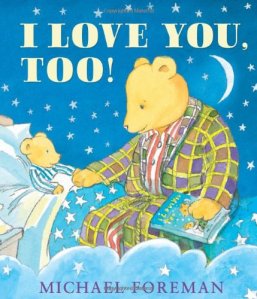 .
.
By Michael Foreman
Andersen Press U. S. A. 3/01/2014
978-1-4677-3451-6
Age 4 to 8 32 pages
.
“Little Bear doesn’t want to go to sleep, so he tries everything he can think of to distract his father, and in the end it’s an exhausted dad who falls asleep!”
Opening
“Dad finished the bedtime story and gently closed the book.”
The Story
Dad Bear tucks his son into bed, reads him a story, and tells his son he loves him. Little Bear has no intentions of going to sleep and so he starts up a back-and-forth he and his dad have done many times: “I love you, I love you more.” It starts out simply and Dad just wants his son to go to sleep.
“I love you three,” said Little Bear, laughing.
“I love you four. Now go to sleep.” said Dad.
“I love you five,” said little Bear.
“I love you even more than that. Now it’s time to sleep,” said Dad.
No, Dad, it is not quite time for bed. Little Bear continues, bringing in his toys, which he loves his dad more than. Dad replies with a simple I love you more, but it will not suffice his son. The boy loves his father more than leaves and birds, all the snowflakes of winter, flowers of summer, colors of the rainbow, and the stars in the sky. To each of his son’s “I love you more than,” Dad replies, “I love you more,” or some variation of this reply. Finally, Dad says,
“You’re only saying that because you don’t want me to go down stairs.”
“No, Dad. It’s because I love you.”
“I love you, too,” said Dad.
“I love you three . . . “
Review
I Love You, Too is a sweet story between a father and son. Picture books need a few more stories involving Dad, who does not get the representation Mom gets in picture books. Poor Dad is usually off to work and, if he is in the book, it is breakfast time and Dad is leaving for work. “Bye kids,” said Dad.
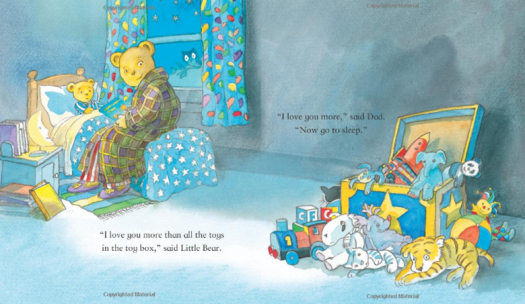
Little Bear uses his imagination to tell his dad all the ways in which he loves him more than. When Little Bear tells dad he loves him more than all his toys, which are in a corner overflowing out of a toy box, the toys look dejected. The stuffed tiger looks downcast, the donkey appears to have shed a tear, and the others—cat, elephant, panda bear, and bunny,—all look unhappy. Little Bear takes dad up into a tree, into the snow, (where there is a snowbear), into a field of flowers, into the ocean, and onto a sandy beach (where dad is buried under the sand sans his head). In every adventure, Dad smiles and replies that he loves his son and it is time for sleep. Stubborn, but happy, Little Bear ignores his father’s admonitions.
The illustrations, all beautifully done in rich watercolors, welcome the two bears, alone for Little Bear’s love-you-more-than-these adventures. Little Bear’s imagination has these two anthropomorphic brown bears perfectly outfitted in each place Little Bear takes them. As Little Bear finds new ways to love his father more than, the two transport into Little Bear’s imagination to that place, be it a field of flowers, a rainy day with puddles to play in, or a starry sky to float through, Dad is as happy as Little Bear, wherever Little Bear’s imagination has taken them. I love how Foreman puts the circle of love in motion once more when Dad said, “I love you, too” and Little Bear takes off with his I love you three, but we never find out what those three things he loves dad more than. Dad has fallen asleep on Little Bear’s bed. Little Bear has gotten his wish. Dad is not going back downstairs. Little Bear picks up the picture book Dad had read him: I Love You, Too!
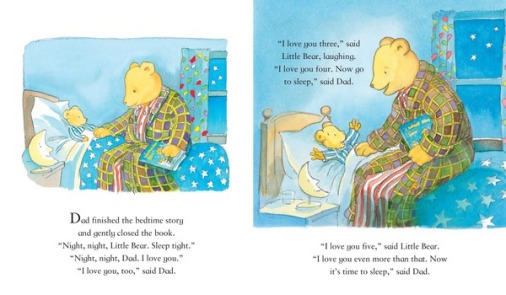
I Love You, Too makes a wonderful bedtime story, though you may find yourself trapped in the “I love you more” merry-go-round, not this is a bad place to be stuck. The story and the illustrations will evoke laughter, smiles, and many “I love you’s” which one can never hear enough. Children will love this story and will soon be using their own imaginations when deciding how much they love a parent more than. I Love You, Too will send many children off to dream land happy and content. If Da Bear is any indication, parents will quickly dose off to their own happy dreamland, maybe even before the last “I love you more than . . . “is said.
I LOVE YOU, TOO! Text and illustrations copyright © 2013 by Michael Foreman. Reproduced by permission of the US distributer, Lerner Publishing Group, Minneapolis, MN.
. First published in Great Britain in 2013 by Andersen Press, Ltd.
.
Purchase a copy of I Love You, Too! at Amazon—B&N—Book Depository—Lerner Publishing—Andersen Press—at your favorite bookstore.
.
Learn more about I Love You, Too! HERE.
Meet the author / illustrator, Michael Foreman, at his wiki page: http://en.wikipedia.org/wiki/Michael_Foreman_%28author_/_illustrator%29
Find more great books at the Lerner Publishing Group website: https://www.lernerbooks.com/
Find even more books at the Andersen Press U. S. A. website: http://www.andersenpress.co.uk/
Andersen Press U. S. A. is an imprint of Andersen Press Ltd.
.
Also by Michael Foreman, released in 2014
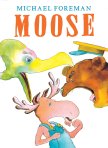
Moose
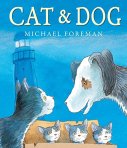
Cat & Dog
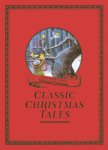
Classic Christmas Tales
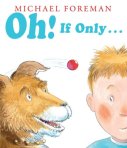
Oh! If Only…
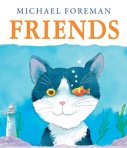
Friends
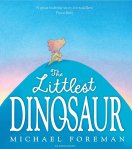
The Littlest Dinosaur
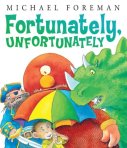
Fortunately, Unfortunately

War Game: Village Green to No-Man’s-Land
(ages 8 to 10)
m
m
m
m
m
m
m
m
m
m
m

m
m
copyright © 2014 by Sue Morris/Kid Lit Reviews

Mount View School, administered by Mr Hotoshe Sema, is a Nursery to Class 10 school located in rural Suruhuto, in Nagaland, India. This school has participated in our Waterbridge Outreach: Books + Water project for the past two year and we recently received students and administrators reactions on the 2011 Book Set. Here is a brief selection , click here to read all.
Selected students’ feedback:
P: Rain School – This is the first time I have heard of students and teachers building a school and I admire they way they did it. The language is quite simple and easy to understand. The main character Thomas’s eagerness to learn and read and his aim to have a new school was very inspiring as he had many obstacles but succeeded in overcoming all these with great determination.
A: Biblioburro – Through this book I come to know that without education, even a rich man is nothing. This is a good lesson for me in life”.
K: A Child’s Garden teaches us not to give up in anything, especially when it is for good.
Selected teachers’ feedback:
Mr. Mughaka:
Biblioburro - Pleasant and inspiring, with sweet, little pictures.
Rain School – Rumford’s Rain School is an encouraging story which will bring smiles to the readers and listeners. Appropriate for kids of any age.
A Child’s Garden – It is a heartening story. It reminds us that hope and determination, and even little things, can do wonders.
Mr. Abenito:
A Child’s Garden – An appreciable illustration about a never ending (undying) hope and concern for that which matures in a person’s mind and soul for a better living and freedom.
Biblioburro – An inspiring and well illustrated story that imparts the significance an individual can play through books.
Rain School – Rumford’s depictions emphasizing a teacher in inspiring and molding a child are quite amazing and interesting.
New on our Outreach site….photos from Pingliang Road No. 3 Elementary School in Shanghai, China. This school has participated in our Spirit of PaperTigers Book Set project for the past two years. Their latest feedback consists of photos of students’ work based on books in the 2011 Book Set: A Child’s Garden: A Story of Hope, written and illustrated by Michael Foreman; Rain School, written and illustrated by James Rumford; and Biblioburro, written and illustrated by Jeanette Winter.
Here’s a sneak peek…..click here to see all the photos.



.

Agape School has participated in our Spirit of PaperTigers Outreach Program for the past two years and recently sent us their feedback (including some lovely photos!) on the 2011 Spirit of PaperTigers Book Set which was comprised of the following three books:
A Child’s Garden: A Story of Hope, written and illustrated by Michael Foreman (Walker Books/Candlewick Press, 2009)
Rain School, written and illustrated by James Rumford (Houghton Mifflin Books for Children, 2010)
Biblioburro, written and illustrated by Jeanette Winter (Beach Lane Books, 2010)
Agape School was established by Lipichem Sangtam, a former journalist who gave up his career to start his own school, and serves 180 primary students ages 4-11. In his 2011 feedback letter to us, Mr. Sangtam writes:
The students are doing well and have been greatly enriched by the story books that you have sent. The students composed illustrated stories in response to reading the 2011 Spirit of PaperTigers Book Set. The beautiful pictures supporting the stories motivated them and they started small paintings with the few colours they have; and they started displaying in the school campus, which is encouraging. The students enjoy reading the books and the quality of the material, which is excellent.
English teacher Jevili Achumi comments:
The stories are filled with images and fanciful layers of illustration which attract the readers. The children were fascinated with the stories, the fanciful characters and the pictures which really take them to the roots. I also appreciate it if the illustrations and stories end up with a best moral.
Here is a sneak peek of the impressive artwork submitted to us. Do take the time to visit Agape School‘s page on our Spirit of PaperTigers Outreach site to see more photos! Click here to be taken there.



 Mal Peet and Elspeth Graham, illustrated by Michael Foreman,
Mal Peet and Elspeth Graham, illustrated by Michael Foreman,
Painting out the Stars
Walker Books, 2011.
Ages 8-11
Three magical stories make up this beautifully presented middle-grade book: “The Mysterious Traveller”, “Night Sky Dragons”, and “Cloud Tea Monkeys”, from which the collection takes its name. Set in unspecified times and countries, they transport readers to the desert, the steppe and a tea plantation respectively. What links them is that they all hinge on inter-generational relationships that will resonate with today’s young readers.
“There were five riders but six camels, travelling fast. Desperately fast.” So opens the first story, “The Mysterious Traveller”. The sixth camel and his precious cargo, a baby girl with a mysterious necklace, are the only survivors following a sandstorm. She is found and adopted by Issa, the most respected guide locally, who calls her Mariamma and teaches her all he knows. The years pass and Issa goes blind, but is still the best guide in the area, with Mariamma’s help. Their lives could have continued along this path, had not some strangers required a guide to take them safely over the mountains…
In “Night Sky Dragons”, young Yazul would rather make kites with his grandfather than follow the path of travel and trade, business and money that his father advocates. He is fond of mischief too, and one day his antics cause untold, if unintentional damage. Yazul despairs that not only will his father never love him, but he’ll never again feel the happiness of flying kites – but when bandits lay siege to their fortified han, Yazul has an idea to save them that could just reconcile both…
In the last of the three stories, a tea-picker falls ill. Her daughter Tashi understands the grinding wheel of poverty: no work, no money, no medicine. “The problem went round and round. It was like a snake with its tail in its mouth and Tashi was frightened by it.” She tries unsuccessfully to pick the tea herself. Despairing, she seeks out the shady spot where she has always shared her lunch with a large monkey family, little realising that they will now repay her kindness and friendship in the most extraordinary way…
It is perhaps no surprise that “Cloud Tea Monkeys” has previously been published as an acclaimed picture-book (illustrated by Jean Wijngaard), and that there are similar plans for the other two stories. Michael Foreman’s black and white illustrations accompanying this edition are charming and add atmosphere, deftly conveying the atmosphere of each story, including the underlying humor in “Cloud Tea Monkeys”. Readers of these great stories will find themselves cheering on the protagonists, while feeling complicit in the storyline by being able to anticipate enough, though not all, of each ending. While the atmospheric description and details beg to be read aloud, the depth of characterisation and the relationships explored make this just the kind of book that independent readers will want to pick up again and again.
Marjorie Coughlan
December 2011

 Since my last update on this year’s PaperTigers Reading the World Challenge, we have added some great books to our list.
Since my last update on this year’s PaperTigers Reading the World Challenge, we have added some great books to our list.
Together, we have read two new autobiographical picture books: Allen Say’s Drawing from Memory (Scholastic, 2011) and Ed Young’s The House Baba Built (Little, Brown and Company, 2011) – both wonderful, and I’m not going to say much more about them here as we will be featuring both of them more fully on PaperTigers soon. Those are our reading-together non-fiction books for the Challenge.
As our local book, we tried reading a book of folk tales from the North York Moors, where we live in the UK, but discovered the stories formed part of a tourist guide, including instructions for getting around… we extracted what we could but it wasn’t a very satisfactory read. It has made us not take beautifully illustrated and retold folk tales for granted!
Older Brother has read Rainbow World: Poems from Many Cultures edited by Bashabi Fraser and Debjani Chatterjee , and illustrated by Kelly Waldek (Hodder Children’s Books, 2003). He dipped in and out of it through the summer break and we had to renew it from the library several times…
 Older Brother has also been totally captivated by A Thousand Cranes: Origami Projects for Peace and Happiness. After reading the story of Sadako for the Reading Challenge way back in its first year, he’s wanted to know how to make the cranes but I have two left hands when it comes to origami – or at least I thought I did, until I received a review copy of A Thousand Cranes from Stone Bridge Press. Recently revised and expanded from the original book by renowned origami expert Florence Temko, it’s a super little book, with good clear instructions for beginners like us, and giving background about both the offering of a thousand origami cranes as a symbol of longevity, and specifically the story of Sadako and the Thousand Cranes. Older Brother, now that he is older, enjoyed reading this factual account here, and learning more about the Peace Park in Hiroshima. He is now determined to make a string of 1,000 cranes himself and send them to the Hiroshima Peace Memorial: full details of how to do this are included in the book. There are also lots of ideas for other craft projects, though I’m not sure any of us is quite up to making anything like the amazing example shown of pictures made with 1,001 cranes as wedding gifts. But with such clear instructions, the only difficulty now is choosing which of the 48 pieces of beautiful Japanese chiyogami
Older Brother has also been totally captivated by A Thousand Cranes: Origami Projects for Peace and Happiness. After reading the story of Sadako for the Reading Challenge way back in its first year, he’s wanted to know how to make the cranes but I have two left hands when it comes to origami – or at least I thought I did, until I received a review copy of A Thousand Cranes from Stone Bridge Press. Recently revised and expanded from the original book by renowned origami expert Florence Temko, it’s a super little book, with good clear instructions for beginners like us, and giving background about both the offering of a thousand origami cranes as a symbol of longevity, and specifically the story of Sadako and the Thousand Cranes. Older Brother, now that he is older, enjoyed reading this factual account here, and learning more about the Peace Park in Hiroshima. He is now determined to make a string of 1,000 cranes himself and send them to the Hiroshima Peace Memorial: full details of how to do this are included in the book. There are also lots of ideas for other craft projects, though I’m not sure any of us is quite up to making anything like the amazing example shown of pictures made with 1,001 cranes as wedding gifts. But with such clear instructions, the only difficulty now is choosing which of the 48 pieces of beautiful Japanese chiyogami

Head on over to the Gallery section of the PaperTigers website to see some of the gorgeous illustrations from Michael Foreman’s A Child’s Garden: A Story of Hope, selected for the 2011 Spirit of PaperTigers Book Set, as well as from a few others of his many books.
One of the questions I asked Michael in our recent interview was about the relationship between color and monochrome, which is so important in conveying the theme of hope in A Child’s Garden. Here’s his reply:
The use of colour was an important element. The boy’s world of rubble is without colour until the tiny green plant appears. As the plant is nurtured, colour gradually comes into the ground. Colour spreads as the plant grows and recedes as the plant is pulled down. Fortunately, roots are deep and seeds spread – and so does the colour.
I also asked about the colour blue, in particular the vibrant shade that appears in so many of his illustrations. Having grown up myself with Michael’s books, then shared them so often with my children, if I close my eyes, it is always that blue that comes into my mind when I think of his work (and you can find it in a stunning image from One World (Andersen Press, new edition 2011) featured in the Gallery). I’m so glad I asked:
That blue is the blue of shallow seas over white sand – the blue that lifts your heart. The blue of our family’s happiest times.
Isn’t that beautiful?
You will find many of the features exploring the new Spirit of PaperTigers Book Set gathered together on our homepage; and do also take a look at our Outreach section, which focuses on the Spirit of PaperTigers project.
 Jack Foreman, illustrated by Michael Foreman,
Jack Foreman, illustrated by Michael Foreman,
Say Hello
Walker Books/Candlewick Press, 2009.
Ages 3-7
“Left out.” The first words of Say Hello sit alone on a page that feels as empty as the world does when we are lonely. A single blue crayon line runs horizontally across the page above a solitary dog, separated even from the two words of text in the opposite corner. From the first spread onward, father-son pair Michael and Jack Foreman gracefully integrates text image and meaning in this poignant book about loneliness, empathy, and our ability to care for each other.
Under the skilled fingers of illustrator Michael Foreman, the horizontal line becomes the silhouette of an empty life, distant buildings, a happy home, trees and even clouds, the story taking shape alongside the line. A solitary dog wanders in search of a friend. He watches a child and cat play. He takes an inquisitive sniff through garbage. Nothing offers the friends he seeks. A group of children playing ball, though – now that offers promise! Happily, he joins the game, having so much fun that he doesn’t see the sad boy drooping nearby. Alone. Despairing. Left out. But when the dog spots him and leaves the fun to draw the boy into the group, we remember, “When someone’s feeling left out, low, / It doesn’t take much to say …Hello!”
This is not the Michael Foreman of exuberant, rambunctious color we so well know. Soft, spare charcoal and pastel drawings superbly reinforce the weight of loneliness the minimal text perfectly captures. “Left out, no fun. / Why am I the only one?” Loneliness is universal, the desire for love and friendship a sign of our humanity. Author Jack Foreman wrote the poem that inspired his text after facing bullies when he was ten years old, but it shows all the skill of adulthood. He parses all unnecessary words so that each piece of text sinks into the subconscious with the weight of the child’s sad, dragging feet. The duo’s deep understanding of space, composition and the power of the phrase “less is more” tactilely reinforces the final take-away: sometimes the smallest gesture makes the biggest impact.
Sara Hudson
October 2011

Michael Foreman,
Mia’s Story: A Sketchbook of Hopes and Dreams
Candlewick Press, 2006.
Ages 4-8
British author-illustrator Michael Foreman was traveling in Chile when he encountered the family on whom he based Mia’s Story. Mia lives in a “village” between Santiago and the snow-capped Andean mountains she can see in the distance. Her village has a name, but really it is a community of poor people built up on the edge of a vast trash dump, which they scour for anything they can fix and re-sell in the city. Foreman’s appealing illustrations intersperse full-page paintings and conventional text with smaller sketches accompanied by handwritten-looking text, like scrapbook entries.
Mia isn’t the poorest of the poor; she lives in a house, albeit one roofed in tin scraps, and most important, she has both her parents. Her father has a truck, and she goes to school. There is even a horse, Sancho, and eventually a puppy, Poco, who provides the plot structure for Foreman’s story. When he goes missing, Mia, wearing the traditional poncho and ear-muffed cap of Andean people, mounts Sancho and goes off looking for her dog. Gradually they climb higher and higher. “From up there she could look down on the dark cloud that always filled the valley.”
Things look scary for a moment, but when Mia and even Sancho realize that the air is clean and the snow is irresistible, they both have a good roll in it. “The sky had never been so blue and so near.” Mia doesn’t find Poco, but she does discover a field of white flowers and returns home with a clump, “roots and all,” that she plants near her house.
By the next spring, those flowers have spread into a field that provides a new source of livelihood for Mia and her family. Mia tells her city customers that the flowers “come from the stars.” She still remembers Poco, especially when packs of dogs run by the cathedral, where she sells her flowers. Happily, by the end of the story, there is a dog in Mia’s life again.
On the back flyleaf, Foreman explains that Mia’s Story was inspired by people for whom “trash was a crop to be harvested, recycled, and made useful once more.” His book subtly introduces young children to a sophisticated ecological concept through a delightful story.
Charlotte Richardson
September 2011
PaperTigers is pleased to announce that A Child’s Garden: A Story of Hope is one of the three books included in the 2011 Spirit of PaperTigers book set.

Michael Foreman,
A Child’s Garden: A Story of Hope
Walker Books / Candlewick Press, 2009.
Ages 5-11
A Child’s Garden: A Story of Hope is a timeless fable with particular relevance for today’s young readers. Michael Foreman, one of the UK’s foremost illustrators and storytellers, has created a masterpiece that combines uncluttered but meaningful prose with beautiful watercolors in contrasting monochrome and joyous, unstoppable color.
A boy finds a “speck of green” among the rubble that is the bleak, monochrome landscape of his home, and nurtures it with almost desperate care. His world is separated from the outside by a tall, barbed wire fence: but as the plant grows, it covers the fence, bringing welcome shade, and birds and butterflies. Other children come there to play and help care for the sturdy vine. Then the unthinkable happens. Soldiers from the other side of the wire rip the vine away, leaving it to die in a ditch. Color has once again gone out of the world. The boy’s heartbreak is palpable.
Life continues through a joyless, cold winter but spring brings with it new growth – on the other side of the fence. A girl appears and nurtures the plants in her turn, under the disinterested eyes of the soldiers. Soon there are shoots on the boy’s side too. Tendrils meet and entwine across the fence, and children on both sides come together to play and tend the vine. The boy realises that it will grow despite the soldiers’ efforts to destroy it – and in the same way, the fence itself will one day disappear. The seeds for that have been sown.
Perfectly honed for young children, A Child’s Garden also has much to offer older readers. At first glance, Foreman’s use of monochrome versus the color of the vine and the life it attracts seems very clear cut. However, a deeper reading, picking out details in the illustrations especially, provides provoking food for thought, reinforcing the tenacity of the seeds of hope not only sown in the boy’s heart but spreading and growing elsewhere. Foreman’s virtuoso illustrations draw out the story’s multilayered complexity and provide wordless stimuli for readers to put out their own tendrils of hope for the future.
A Child’s Garden is a moving, empowering read that, like all good fables, will leave a lasting, deep-rooted impression on its readers.
Marjorie Coughlan
September 2011
Michael Morpurgo is one of the greats in contemporary British children’s literature - he is a master craftsman of storytelling who weaves fiction into such convincing historical contexts that you have to pinch yourself to remember the characters came out of his imagination
 Two of his recent stories for older children have a wartime setting: but both stories also have roots in the present and a new generation, which bring a perspective of hope and renewal to counterbalance the feelings of despair engendered by these examples of the futility and madness of war. The Best Christmas Present in the World (Egmont, 2004) centres around a letter from Jim Macpherson, an English officer in the First World War, which relates the extraordinary events of the momentary truce and famous football game between the British and the Germans on Christmas Day, 1914. Many years later, at Christmas time, the letter is found in an old, second-hand desk by the narrator. It is marked as “Jim’s last letter, received 25th January 1915. To be buried with me when the time comes.” And so our narrator sets out to find “Dearest Connie” - and gives her the best Christmas present in the world…
Two of his recent stories for older children have a wartime setting: but both stories also have roots in the present and a new generation, which bring a perspective of hope and renewal to counterbalance the feelings of despair engendered by these examples of the futility and madness of war. The Best Christmas Present in the World (Egmont, 2004) centres around a letter from Jim Macpherson, an English officer in the First World War, which relates the extraordinary events of the momentary truce and famous football game between the British and the Germans on Christmas Day, 1914. Many years later, at Christmas time, the letter is found in an old, second-hand desk by the narrator. It is marked as “Jim’s last letter, received 25th January 1915. To be buried with me when the time comes.” And so our narrator sets out to find “Dearest Connie” - and gives her the best Christmas present in the world…
 Meanwhile, The Mozart Question (Walker Books, 2008) is the story of a world-famous violinist, Paolo Levi, whose parents’ lives were saved in the Second World War through playing the violin in an orchestra at a Nazi concentration camp. Lesley, the story’s narrator, is a young journalist who is sent to Venice to interview Paolo. She pointedly does not ask him the forbidden Mozart question - but the time is right for him to talk about it. He tells her about how he secretly began to play the violin, not realising that there were secrets he did not know about his parents’ past; and how eventually his playing “made music joyful” for his father once more.
Meanwhile, The Mozart Question (Walker Books, 2008) is the story of a world-famous violinist, Paolo Levi, whose parents’ lives were saved in the Second World War through playing the violin in an orchestra at a Nazi concentration camp. Lesley, the story’s narrator, is a young journalist who is sent to Venice to interview Paolo. She pointedly does not ask him the forbidden Mozart question - but the time is right for him to talk about it. He tells her about how he secretly began to play the violin, not realising that there were secrets he did not know about his parents’ past; and how eventually his playing “made music joyful” for his father once more.
Reading these books aloud to older children prompts a lot of questions and discussion. As Morpurgo says in his Author’s Note at the end of The Mozart Question:
It is difficult for us to imagine how dreadful was the suffering that went on in the Nazi concentration camps during the Second World War [...] It is when you hear the stories of the individuals who lived through it - Anne Frank, Primo Levi - that you begin to understand the horror just a little better…
By presenting these individual, albeit fictional accounts, Morpurgo is helping to ensure that the facts continue to be put before a new generation, that they may learn from them - and, dare I say it, he does so in a way that will probably have much more impact than a history lesson. His prose begs to be read aloud; and both books also have the distinct advantage of being illustrated by Michael Foreman - Morpurgo and Foreman really do make a wonderful team! And when they’ve listened to the stories and talked about them, children will want to go away and read them quietly on their own - again and again.
You can find other reviews of The Mozart Question on 100 Scope Notes, Shelf-Employed and Achukareviews; and one I could really empathise with at Findlay Library Kids.
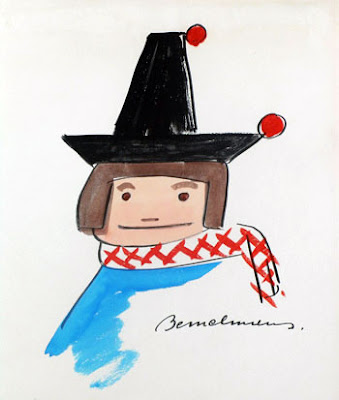 BY LUDWIG BEMELMANS via Chris Beetles
BY LUDWIG BEMELMANS via Chris Beetles
Good literature promotes literacy. Reading to children promotes literacy. Promoting a love of books through the example of reading promotes literacy. And sharing a story together, at the end of the day especially, offers a moment of harmony and oasis in family life, which sometimes has to be safe-guarded from the encroachment of action-packed schedules. So all in all, a bedtime story is a win-win scenario, whichever way you look at it!
It can, however, be a daunting prospect for some parents, so today on Books at Bedtime I’d like to focus on two resources which offer parents some tools to help make storytelling a joy for all concerned.
The first is the Storytelling Bibliographies page on The Center for Children’s Books’ website. These booklists encompass stories from all over the world which make great readalouds, arranged by themes such as Phases of the Moon, Tales about Fools, Latino Folktales, Native American Tales… The links to Storytelling Websites offer rich scope and I especially like thie process advocated here for using a book as a springboard for someone to tell a story; and for listeners then to extend that storytelling experience. Such activities will lead children to love books and to love words themselves… the next generation of storytellers and writers?
 And the other resource is Australian writer Mem Fox reading extracts from her book Reading Magic – her web-page And Do It Like This offers a step-by-step guide to reading stories aloud to children. She also has her 10 Read Aloud Commandments – here’s number 10 :
And the other resource is Australian writer Mem Fox reading extracts from her book Reading Magic – her web-page And Do It Like This offers a step-by-step guide to reading stories aloud to children. She also has her 10 Read Aloud Commandments – here’s number 10 :
Please read aloud every day, mums and dads, because you just love being with your child, not because it’s the right thing to do.
And you can hear her putting all these hints and pieces of advice into action herself, reading three of her stories, including her avowed favorite Koala Lou: and she reads them beautifully.
Let's hope for a British win - at least one of them!
I don't agree with Cally, by the way - all kinds of factors will lead to e-books taking over from paper books, including economic, environmental, social and the fact that children can't learn to read on a screen the size of an iPhone so they will have to start with something larger format at least. Of course, it might just lead to reduced literacy, but I'm an optimist! Paper books may reduce in numbers but won't go away.
I'll be interested in seeing a pop-up ebook ... :-)